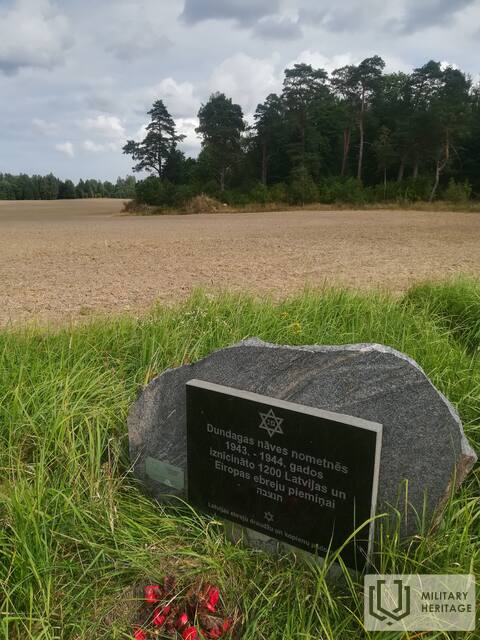Star of David at the Dundagh Concentration Camp Memorial
After regaining independence, the residents of Dundaga installed a large wooden star of David at the place of the murder and reburial of the Jews near the Mazirbe - Dundaga highway, and later the Council of Jewish Congregations and Communities of Latvia opened a memorial stone next to it.
The concentration camp Dundagen II (Dondagen II) was opened on 26.11.1943 and its first commandant is Gröschel Max Ernst. From the initial 155 prisoners (1944), the camp was expanded to 1000 prisoners. Most of the prisoners are from the ghettos of Riga, Vilnius, Daugavpils and Liepāja, as well as ghettos of other German-occupied countries. The prisoners are women and children, who are employed in warehouses, building barracks, forestry, railway and bunker construction, as well as airfield construction.
The camp is evacuated when the Red Army 24-25.07.1944. reaches Tukuma. It takes place by railway to Liepāja and Ventspils and further to the Stutthof concentration camp. Gräschel was convicted by the SS and police court for crimes committed in the Riga-Kaiserwald concentration camp (SS camp Dondangen), he was sent to the Stutthof SS and police concentration camp in Danzig-Matzkau.
Greschel tortured the prisoners so cruelly that many suffered fatal injuries and died. He was sentenced to death by the Dresden court on February 23, 1951, and executed in Dresden prison on June 23, 1951.
In June 1992, thanks to the initiative of local researcher Jautrīte Freimutes, the inhabitants of Dundaga installed a large wooden star of David at the site of the murder and reburial of the Jews in Čiekuros, which has not survived in the object.
However, in October 2007, the Council of Jewish Congregations and Communities of Latvia also opened a memorial stone next to it with two stars of David and an inscription in Latvian "Dundagas death camps 1943-1944. in memory of the 1,200 Latvian and European Jews who were destroyed in The opening of the monument was attended by representatives of the Council of Jewish Congregations and Communities of Latvia, the government and local government, as well as the embassies of Germany, Israel, Slovakia, the Czech Republic, Austria and Hungary.
http://www.tenhumbergreinhard.de/1933-1945-lager-1/1933-1945-lager-d/dundaga-ii-dondangen.html
Related timeline
Related objects
Memorial to the victims of holocaust in Liepāja
The largest memorial to Holocaust victims in Latvia is located in Liepāja, in the Šķēde dunes. The memorial is dedicated to the memory of more than 3,000 Liepāja Jews killed during World War II. It is in the form of the Israeli national symbol, a seven-branched candelabra known as the menorah. The contours of the memorial, which are clearly visible from a bird’s eye view, are made of split boulders and granite blocks. The ‘lights’ of the menorah are made of granite pillars with inscriptions of verses from the Lamentations of Jeremiah in Hebrew, English, Latvian and Russian.
Riga Ghetto and Latvian Holocaust Museum
The Riga Ghetto and the Latvian Holocaust Museum is located in Riga close to the Riga Central Market and the Riga Central Station. The museum was opened in 2010 on the site where the city's warehouses once were. It is located in the historical part of the city, next to the border of the former Jewish ghetto. The territory of the ghetto is unique, because in terms of architecture it has not changed since World War II. It is a memorial dedicated to the tragedy suffered by the Jewish people. The German policy regarding the Jewish population in Latvia until the end of 1939 was for the German diplomats and politicians to try and pressure the Latvian government to take action against the Jews by restricting their freedom. After the emigration of the Baltic Germans in 1939, the German embassy no longer had as good an access to information on the mood of the population and the events happening in Latvia as before. When the Red Army occupied Latvia, they manipulated the society to gain some support of the Jewish population for the new occupying power. However, after the regime started a crackdown on the society as a whole, the support fell rapidly. As a result of all this, a deep divide had formed between the people. And later on, the next regime – Germany – tried to exploit it. They hoped that the local population would harass and attack the Jews, but that did not happen. So, Germany adjusted their approach and devised a new plan to initially establish a Jewish ghetto and later destroy its inhabitants.









